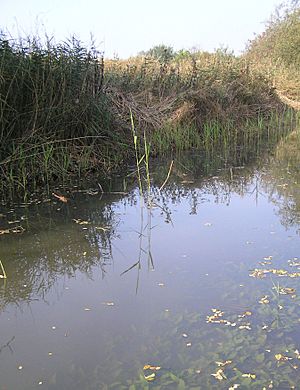Fowlmere RSPB reserve facts for kids
| Site of Special Scientific Interest | |

Fowlmere from the Reedbed Hide
|
|
| Area of Search | Cambridgeshire |
|---|---|
| Interest | Biological |
| Area | 39.9 hectares |
| Notification | 1982 |
| Location map | Magic Map |
Fowlmere is a special nature reserve managed by the Royal Society for the Protection of Birds (RSPB). You can find it between the villages of Fowlmere and Melbourn in Cambridgeshire, England. This amazing place is officially known as a biological Site of Special Scientific Interest (SSSI) called Fowlmere Watercress Beds, covering about 39.9 hectares (that's like 100 football fields!).
The reserve is full of reedbeds and pools, which get their water from natural chalk springs. A clear chalk stream also flows right through the area. If you visit, you'll find three bird hides, which are perfect for watching wildlife without disturbing them. One of these hides is even easy to use for people in wheelchairs. Fowlmere is a fantastic spot for birdwatching, where you might see colourful kingfishers, shy water rails, and singing sedge warblers, reed warblers, and grasshopper warblers. In winter, many corn buntings gather here to roost.
Contents
A Look Back: Fowlmere's Story
The RSPB bought Fowlmere in 1977. Guess what? The money to buy it was raised by the RSPB's junior members during a sponsored birdwatch! The name "Fowlmere" comes from how the area used to be before the 1800s. Back then, it was a big open lake, a perfect home for lots of wildfowl (like ducks and geese).
In the 1850s, people tried to drain the area, but it didn't work. Then, in the 1890s, something new started: growing watercress! Farmers dug ponds and lined them with clay. They even found a clever way to control the water levels by pushing pipes into the ground. Water would bubble up from these pipes, and some still flow today when there's enough water underground.
However, because people in nearby towns use a lot of water, the natural springs don't flow as much as they used to. During dry times, the Environment Agency helps out by adding extra water to the reserve. The watercress grown here was washed and packed right on site. Then, it was taken by horse and cart to Shepreth station and sent all the way to Covent Garden Market in London. Watercress farming continued until the 1960s. After that, the old cress beds became overgrown with reeds. Now, the reserve is carefully managed to protect all its different habitats.
Exploring the Reserve
Fowlmere covers about 40 hectares, which is a pretty big area to explore! There's a 3-kilometre nature trail that lets you walk around and discover the different parts of the reserve. Some sections of the trail are even suitable for wheelchairs, making it easier for everyone to enjoy. If you arrange it with the warden, you can even try "pond dipping," which is a fun way to discover the tiny creatures living in the water.
On sunny days, especially from spring to late autumn, keep an eye out for amazing insects. You'll often see colourful dragonflies and delicate damselflies flying around the water.
How the Habitats are Managed
The reedbeds at Fowlmere are very important, but if they weren't looked after, they would eventually dry out. To stop this from happening, a small part of the reeds is cut down every autumn. These cut reeds are then either burned or removed from the site. This helps keep the reedbeds healthy and wet.
Other parts of the reserve are being managed to bring back chalk grassland. This is a special type of grassland that grows on chalky soil. One area is grazed by cattle and sheep. Their grazing helps wildflowers like cowslips, southern marsh orchids, and goatsbeard to grow. Another area is mown in late autumn, and the cut plants are raked away. This stops the soil from becoming too rich, which would allow stronger, common plants to take over and push out the rarer wildflowers.
How to Visit
You can get to Fowlmere Nature Reserve from the road that connects the cemetery on Shepreth Road to Cambridge Road.


